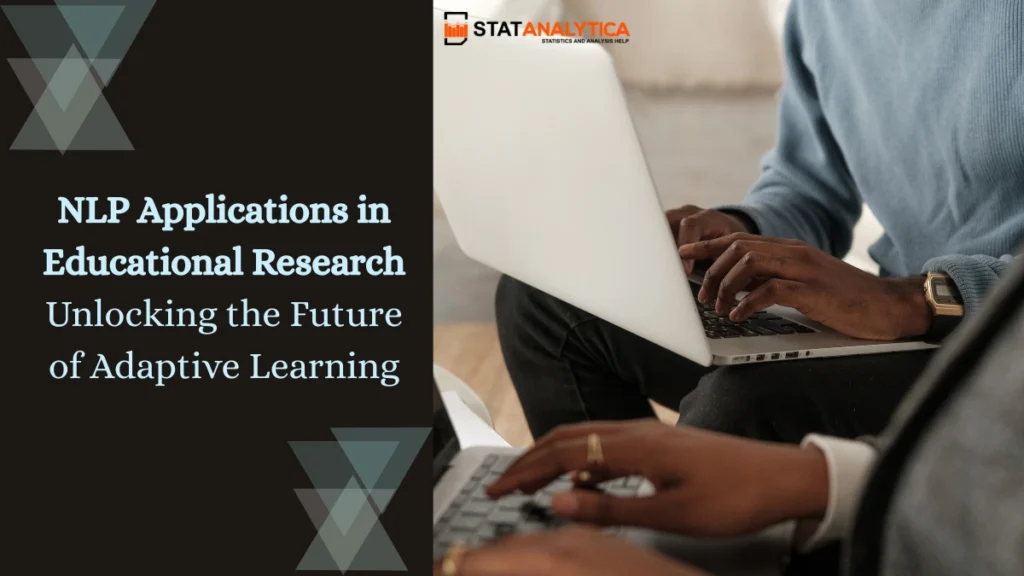We live in a world where technology effortlessly understands our spoken commands, completes our text messages, and polishes our written work with automated grammar checks. These seamless, nearly magical interactions are powered by a field of Artificial Intelligence (AI) called Natural Language Processing (NLP).
NLP is essentially a sophisticated translator and analyst: it teaches computers to understand, interpret, and generate human language—whether spoken or written—with increasing accuracy. It takes the messy, context-dependent, and vast world of human communication and transforms it into structured data that machines can efficiently analyze.
In the critical and challenging field of educational research, NLP is proving to be a revolutionary tool. Researchers, instructors, and curriculum developers are leveraging it to answer major, resource-intensive questions: “How can learning be made truly adaptive and personal for every student, regardless of class size?” and “How can we gather meaningful, actionable feedback from thousands of students efficiently and fairly?”
This exploration will dive into the most powerful applications of NLP that are currently shaping the future of teaching, learning, and assessment, demonstrating how AI is becoming a core partner in academic success.
NLP Applications in Educational Research
Table of Contents
Part 1: Deconstructing Language: How NLP Achieves Understanding
To fully appreciate NLP’s profound role in education, one must first grasp how it moves beyond simple keyword matching to genuine comprehension. When a person reads the phrase, “The seminar was a blast,” they instantly understand “blast” means exciting or successful in that context. NLP achieves this comprehension through multiple analytical layers that mimic—and in some ways, exceed—human linguistic ability:
- Linguistic Parsing (Tokenization & POS Tagging): The initial step is to break the text down into its core components. The sentence is segmented into individual units, or tokens (e.g., “The,” “seminar,” “was,” “a,” “blast”). Then, Part-of-Speech (POS) Tagging automatically labels each token (e.g., “seminar” is a Noun, “was” is a verb). This foundational process converts chaotic, continuous text into a predictable, machine-readable structure.
- Semantic Analysis and Context: This is the analytical heart. NLP uses massive, pre-trained language models, such as Transformer architectures (like BERT or GPT), to check the word “blast” against the surrounding context (“seminar”). It figures out that the word is used to convey a strongly positive sentiment rather than a negative, literal meaning. This ability to interpret the vibe or tone of a text is critical for interpreting student feedback accurately.
- Entity Recognition and Relationship Mapping: Advanced systems employ Named Entity Recognition (NER) to instantly identify and classify important, standalone concepts (e.g., recognizing “IIT Delhi” as a ‘Location’ or “Quantum Physics” as a ‘Topic’). Furthermore, Relationship Extraction figures out how these entities are connected within the text (e.g., that ‘Dr. Sharma’ is the ‘instructor’ of ‘Quantum Physics’). This allows the machine to map knowledge and conceptual understanding.
- Syntactic and Dependency Parsing: Moving beyond individual word meaning, NLP analyzes the grammatical structure of a sentence. Dependency Parsing maps the relationships between words (e.g., which noun is the subject, which verb is the main action). This is crucial in assessment, as it helps determine if a student is writing with complex, grammatically sound structures or with simple, repetitive phrases.
By performing these complex, multi-layered operations, the computer moves from merely processing symbols to genuinely comprehending the concepts, relationships, and intent within educational materials and, crucially, within student responses.
Part 2: Direct Applications: Enhancing Teaching and Learning
The research and development in NLP have led directly to practical tools that profoundly improve the educational experience for individuals across all learning levels, from elementary school to university and professional training.
1. Automated Essay Scoring (AES) and Feedback Systems
The Challenge: Grading large volumes of student writing is a time-intensive, subjective task for educators, resulting in feedback delays that significantly diminish the student’s ability to act upon the advice while the assignment is still relevant.
The NLP Solution: AES systems employ highly sophisticated NLP and machine learning techniques to evaluate written work instantly and with remarkable consistency.
- Beyond Surface-Level Checks: Modern AES goes far past simple error detection. It uses Cohesion Analysis to assess the logical flow and coherence between sentences and paragraphs, Lexical Richness to gauge the sophistication and variety of vocabulary, and Argumentation Structure analysis to check for the proper sequencing of claims, evidence, and counter-arguments. Research consistently shows these objective metrics correlate strongly with high human grades.
- The Scalability and Consistency Benefit: The system ensures that every student, regardless of their position in the grading queue, receives feedback based on the exact same rubric. This not only frees up instructor time for more high-value, one-on-one student coaching but also provides the student with the immediate, specific, and actionable critique they need: “Your supporting evidence in paragraph 3 is insufficient; include a specific historical date or fact.”
2. Intelligent Tutoring Systems (ITS) and Adaptive Learning
The Challenge: In classrooms or online courses with large enrollments, the sheer numbers make it impossible for instructors to dynamically monitor and address every student’s specific knowledge gaps in real-time.
The NLP Solution: ITS are designed to create truly adaptive learning environments—systems that provide tailored, one-on-one virtual instruction.
- Dynamic Learner Modeling: When a student interacts with the system (by asking questions, submitting short answers, or making mistakes), the NLP engine rigorously analyzes their language. It uses the language patterns and errors to build a Learner Model—a real-time profile of the student’s conceptual strengths and weaknesses. For instance, it can detect if a student is confusing the definitions of two terms versus misunderstanding the relationship between them.
- Personalized Intervention: Based on this precise model, the ITS uses Natural Language Generation (NLG) to formulate and deliver a perfectly tailored instructional response: a hint, a specific formula reminder, or a newly generated practice problem designed only to remediate the identified conceptual deficit. This level of personalization is proven to increase mastery and significantly reduce the time spent on concepts already understood.
Part 3: NLP in Educational Research and Administration
NLP’s impact extends to helping institutions understand and improve their policies, curriculum, and the entire learning ecosystem.
1. Mining for Gold in Feedback (Topic Modeling and Sentiment)
Educational institutions and researchers constantly deal with huge volumes of unstructured text data from course evaluations, open-ended surveys, and online discussion forums.
- The Research Goal: To quickly extract meaningful, actionable insights and identify priorities from thousands of student voices.
- How NLP Helps: Researchers apply Topic Modeling (like Latent Dirichlet Allocation) to automatically scan all the text and cluster similar comments into abstract themes (e.g., ‘Instructor Clarity,’ ‘Facilities Maintenance,’ ‘Course Load’). They then combine this with Sentiment Analysis, which assigns an emotional score (positive, negative, neutral) to the language within each topic.
- The Result: Administrators receive objective, prioritized reports, such as: “Student feedback shows a highly positive sentiment toward Instructor X, but a strong negative sentiment across 80% of comments related to library seating availability.” This data-driven approach allows for strategic and resource-efficient organizational change.
2. Curriculum Vetting, Design, and Policy Analysis
Ensuring a curriculum is comprehensive, logically sequenced, and appropriately challenging is vital for any academic program.
- The Research Goal: To objectively measure the coverage, complexity, and policy alignment of massive textual resources.
- How NLP Helps:
- Complexity Check: Tools calculate readability scores to ensure textbooks and course materials are appropriately leveled for the target audience.
- Gap Analysis: Advanced models can perform content alignment analysis, checking if the learning objectives and assessment criteria of a course are fully covered by the assigned readings and lectures, instantly flagging any missing concepts.
- Policy Review: Researchers use NLP to analyze thousands of official government or institutional policy documents, quickly identifying thematic shifts (e.g., a move in focus from ‘access’ to ‘student debt’) that inform decision-making.
3. Predictive Modeling and Early Intervention
By analyzing student-generated text on learning platforms, NLP contributes to sophisticated models designed to predict academic risk.
- How it Works: The system analyzes subtle linguistic cues, such as a student’s sudden drop in syntactic complexity in essays, an increase in negative sentiment in discussion board posts, or a change in the type of questions they ask an AI tutor (moving from complex to rudimentary queries). These changes are weighted against a baseline.
- The Benefit: Researchers can build models that flag students displaying patterns associated with disengagement or dropping out. This allows human advisors or instructors to initiate a timely, human intervention—not a punitive measure—before a small academic hurdle becomes a major crisis.
Also Read: 50+ NLP Project Ideas for Language Processing Enthusiasts
Conclusion: A New Era of Learning
Natural Language Processing is not merely a fashionable technology; it is a foundational element that is enabling a paradigm shift in education. By allowing machines to genuinely interact with and understand human communication, we are unlocking scalable, objective, and individualized solutions to long-standing challenges in teaching and assessment.
This technology ensures:
- Hyper-Personalization: Learning is tailored to the unique pace and conceptual needs of every individual.
- Enhanced Efficiency and Focus: Instructors gain back time from administrative tasks to focus on mentorship, complex discussions, and creative teaching.
- Equity and Accessibility: NLP-driven tools break down language and accessibility barriers, democratizing high-quality education.
As the field continues to evolve toward more empathetic and context-aware models, the future of learning will be defined by intelligent systems that serve as powerful, ethical, and indispensable partners to every learner and educator. For a deeper, academic perspective on the taxonomy and trends of this field, consult this comprehensive survey on Natural Language Processing for Education.


